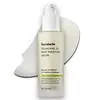What's inside
What's inside
 Key Ingredients
Key Ingredients

 Benefits
Benefits

 Concerns
Concerns

No concerns
 Ingredients Side-by-side
Ingredients Side-by-side

Polyisobutene
Tridecyl Trimellitate
EmollientHydrogenated Polyisobutene
EmollientOctyldodecanol
EmollientWater
Skin ConditioningDextrin Palmitate
EmulsifyingSilica Dimethyl Silylate
Emollient1,2-Hexanediol
Skin ConditioningTocopherol
AntioxidantEthylene/Propylene/Styrene Copolymer
Helianthus Annuus Seed Oil
EmollientCaprylyl Glycol
EmollientDimethicone
EmollientPentaerythrityl Tetra-Di-T-Butyl Hydroxyhydrocinnamate
AntioxidantEthylhexylglycerin
Skin ConditioningSodium Dna
Skin ConditioningButylene Glycol
HumectantButylene/Ethylene/Styrene Copolymer
Propanediol
SolventSaccharide Isomerate
HumectantBrassica Oleracea Italica Extract
AstringentHyaluronic Acid
HumectantHydrolyzed Sodium Dna
Skin ConditioningTripeptide-1
Skin ConditioningGlycerin
HumectantMyrothamnus Flabellifolia Leaf/Stem Extract
HumectantSodium Hyaluronate Crosspolymer
HumectantPantothenic Acid
Skin ConditioningCitric Acid
BufferingSodium Citrate
BufferingAscorbic Acid
AntioxidantPolyglutamic Acid
Skin ConditioningXylose
HumectantAcetyl Hexapeptide-8
HumectantPolyisobutene, Tridecyl Trimellitate, Hydrogenated Polyisobutene, Octyldodecanol, Water, Dextrin Palmitate, Silica Dimethyl Silylate, 1,2-Hexanediol, Tocopherol, Ethylene/Propylene/Styrene Copolymer, Helianthus Annuus Seed Oil, Caprylyl Glycol, Dimethicone, Pentaerythrityl Tetra-Di-T-Butyl Hydroxyhydrocinnamate, Ethylhexylglycerin, Sodium Dna, Butylene Glycol, Butylene/Ethylene/Styrene Copolymer, Propanediol, Saccharide Isomerate, Brassica Oleracea Italica Extract, Hyaluronic Acid, Hydrolyzed Sodium Dna, Tripeptide-1, Glycerin, Myrothamnus Flabellifolia Leaf/Stem Extract, Sodium Hyaluronate Crosspolymer, Pantothenic Acid, Citric Acid, Sodium Citrate, Ascorbic Acid, Polyglutamic Acid, Xylose, Acetyl Hexapeptide-8
Water
Skin ConditioningGlycerin
HumectantSqualane
EmollientPropanediol
SolventDipropylene Glycol
HumectantButylene Glycol
HumectantMethyl Trimethicone
Skin ConditioningHydroxyethyl Acrylate/Sodium Acryloyldimethyl Taurate Copolymer
Emulsion StabilisingPolyglyceryl-2 Stearate
EmulsifyingCetearyl Olivate
Glyceryl Stearate
EmollientSodium Polyacrylate
AbsorbentStearyl Alcohol
EmollientSorbitan Olivate
EmulsifyingCarbomer
Emulsion StabilisingTromethamine
BufferingEthylhexylglycerin
Skin ConditioningGlyceryl Acrylate/Acrylic Acid Copolymer
HumectantSorbitan Isostearate
EmulsifyingSodium Phytate
Parfum
MaskingSodium Hyaluronate
HumectantCoptis Japonica Root Extract
Skin ConditioningDioscorea Japonica Root Extract
Skin ConditioningNatto Gum
Tocopherol
AntioxidantPinus Densiflora Leaf Extract
AntimicrobialAnastatica Hierochuntica Extract
AstringentWater, Glycerin, Squalane, Propanediol, Dipropylene Glycol, Butylene Glycol, Methyl Trimethicone, Hydroxyethyl Acrylate/Sodium Acryloyldimethyl Taurate Copolymer, Polyglyceryl-2 Stearate, Cetearyl Olivate, Glyceryl Stearate, Sodium Polyacrylate, Stearyl Alcohol, Sorbitan Olivate, Carbomer, Tromethamine, Ethylhexylglycerin, Glyceryl Acrylate/Acrylic Acid Copolymer, Sorbitan Isostearate, Sodium Phytate, Parfum, Sodium Hyaluronate, Coptis Japonica Root Extract, Dioscorea Japonica Root Extract, Natto Gum, Tocopherol, Pinus Densiflora Leaf Extract, Anastatica Hierochuntica Extract
 Reviews
Reviews

Ingredients Explained
These ingredients are found in both products.
Ingredients higher up in an ingredient list are typically present in a larger amount.
Butylene Glycol (or BG) is used within cosmetic products for a few different reasons:
Overall, Butylene Glycol is a safe and well-rounded ingredient that works well with other ingredients.
Though this ingredient works well with most skin types, some people with sensitive skin may experience a reaction such as allergic rashes, closed comedones, or itchiness.
Learn more about Butylene GlycolEthylhexylglycerin (we can't pronounce this either) is commonly used as a preservative and skin softener. It is derived from glyceryl.
You might see Ethylhexylglycerin often paired with other preservatives such as phenoxyethanol. Ethylhexylglycerin has been found to increase the effectiveness of these other preservatives.
Glycerin is already naturally found in your skin. It helps moisturize and protect your skin.
A study from 2016 found glycerin to be more effective as a humectant than AHAs and hyaluronic acid.
As a humectant, it helps the skin stay hydrated by pulling moisture to your skin. The low molecular weight of glycerin allows it to pull moisture into the deeper layers of your skin.
Hydrated skin improves your skin barrier; Your skin barrier helps protect against irritants and bacteria.
Glycerin has also been found to have antimicrobial and antiviral properties. Due to these properties, glycerin is often used in wound and burn treatments.
In cosmetics, glycerin is usually derived from plants such as soybean or palm. However, it can also be sourced from animals, such as tallow or animal fat.
This ingredient is organic, colorless, odorless, and non-toxic.
Glycerin is the name for this ingredient in American English. British English uses Glycerol/Glycerine.
Learn more about GlycerinPropanediol is an all-star ingredient. It softens, hydrates, and smooths the skin.
It’s often used to:
Propanediol is not likely to cause sensitivity and considered safe to use. It is derived from corn or petroleum with a clear color and no scent.
Learn more about PropanediolTocopherol (also known as Vitamin E) is a common antioxidant used to help protect the skin from free-radicals and strengthen the skin barrier. It's also fat soluble - this means our skin is great at absorbing it.
Vitamin E also helps keep your natural skin lipids healthy. Your lipid skin barrier naturally consists of lipids, ceramides, and fatty acids. Vitamin E offers extra protection for your skin’s lipid barrier, keeping your skin healthy and nourished.
Another benefit is a bit of UV protection. Vitamin E helps reduce the damage caused by UVB rays. (It should not replace your sunscreen). Combining it with Vitamin C can decrease sunburned cells and hyperpigmentation after UV exposure.
You might have noticed Vitamin E + C often paired together. This is because it is great at stabilizing Vitamin C. Using the two together helps increase the effectiveness of both ingredients.
There are often claims that Vitamin E can reduce/prevent scarring, but these claims haven't been confirmed by scientific research.
Learn more about TocopherolWater. It's the most common cosmetic ingredient of all. You'll usually see it at the top of ingredient lists, meaning that it makes up the largest part of the product.
So why is it so popular? Water most often acts as a solvent - this means that it helps dissolve other ingredients into the formulation.
You'll also recognize water as that liquid we all need to stay alive. If you see this, drink a glass of water. Stay hydrated!
Learn more about Water